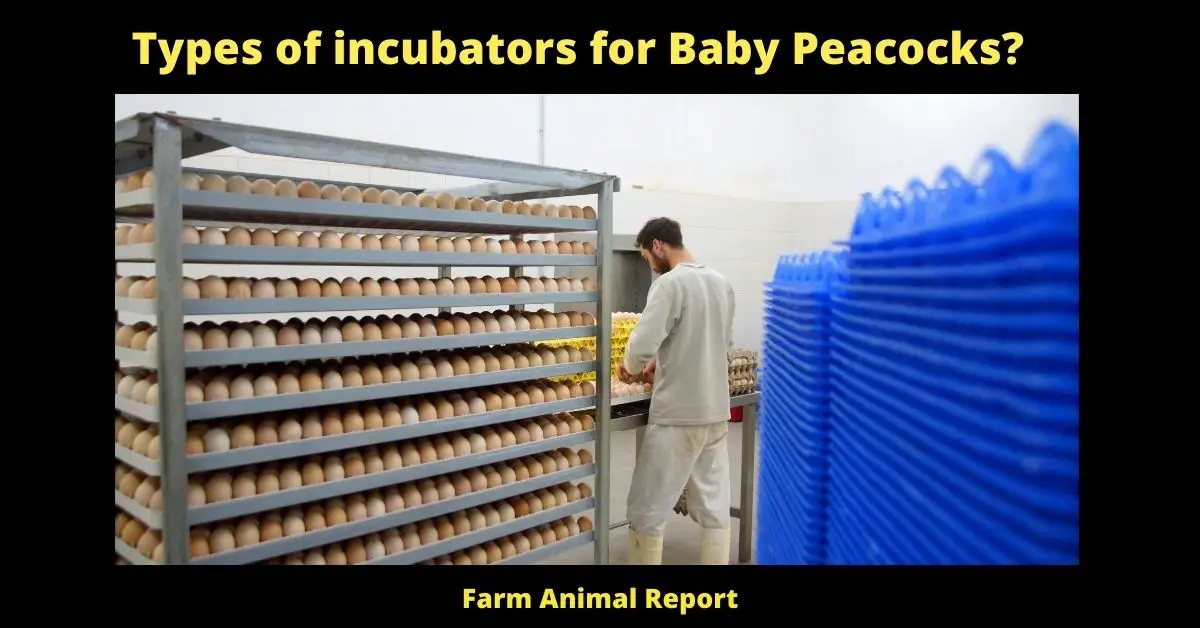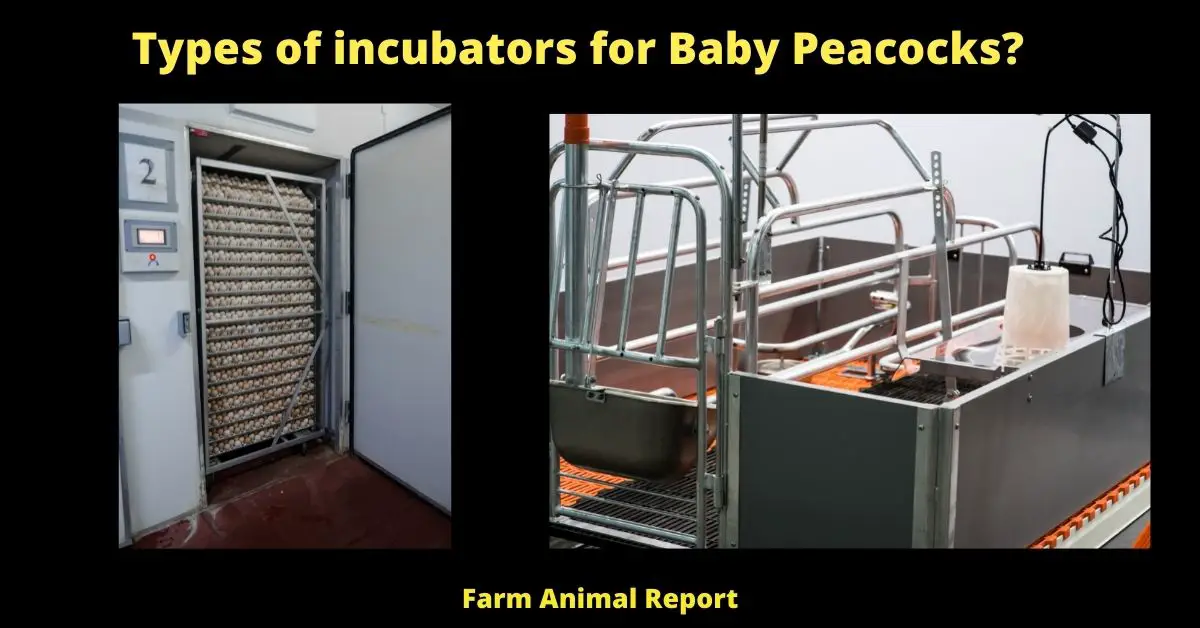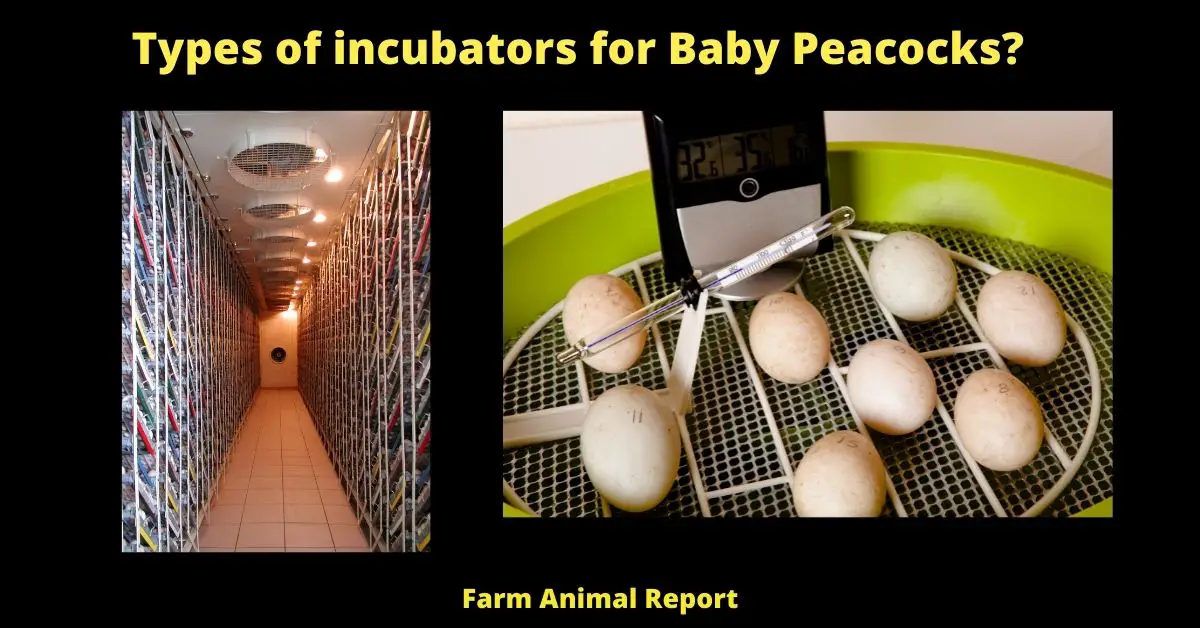There are basically Four types of Peacock Egg Incubators, Air heated, Forced Air, Heat Generated, and commercial Incubators
Types of incubators for Baby Peacocks? Peachicks/Peafowl/Peahens
Incubators are used to artificially simulate the natural environment for baby birds. There are many different types of incubators, and it’s important to make sure you select one that will fit your needs. This article talks about the various types of incubators available for Baby Peacocks, their benefits and drawbacks, and what they’re best suited for!
Incubators allow you to control the temperature, humidity, and light level of your baby peafowl. They range in egg capacities from small to very large, so you can choose the one that best suits your needs.
Jump to Peachicks – Baby Peacocks **NEWBORN**
There are three main types of incubators: air-heated ovens (smaller), still air machines (larger), and forced heated-air machines (a bit larger). Air-heated ovens rely on the heat generated.

Air-Heated Ovens Peachick Incubator
Air Heated ovens are an inexpensive, simple way to incubate eggs.
The dangers of an Air-Heated oven are that the eggs can overheat and it takes a long time to achieve temperatures for hatching (36 hours).
You can incubate eggs in an Air-Heated oven by
Plugging the incubator into a GFCI outlet or using a battery-operated thermometer with an alarm.
Sharpie marker to label each tray of eggs for easy rotation.
Rotate trays once per day to ensure even heat distribution and prevent hot spots.
Place a pan of water in the oven on the lowest shelf to add humidity, but be careful not to let it overflow onto your eggs.
If you are using an Air-Heated incubator, we recommend:
The Brinsea Eco 20 Advance or the OvaEasy 100. Both of these incubators have a temperature controller and automatic turner. The Brinsea Eco 20 Advance has the highest hatch rate, while the OvaEasy 100 is more affordable.
An Air-Heated oven can cost anywhere from $30 to over $200 depending on the features and size you need for your incubator.
Some other features you may want to look for include an automatic turner, digital thermometer and hygrometer, and a built-in fan for airflow.
You can incubate approximately 12 eggs in an Air-Heated oven.
Forced Heated air incubators
This type of incubator works by heating the air to provide warmth for eggs.
Forced Heated air incubators are usually used when you want to hatch several different kinds of birds at once, or if your climate is very cold and it’s too difficult (or expensive) to heat every single box individually.
This type of incubator can be temperature controlled by the user,
making it a popular choice for those who are serious about hatching eggs.
The main drawback to using a Forced Heated air incubator is the fact that you can’t see inside the incubator to check on your eggs –
meaning you’ll need to do some additional checking from outside of the incubator to make sure your eggs are doing well.
If you’re looking for an incubator that will do a great job of heating your eggs, a Forced Heated air incubator is a good option to consider.
You can incubate approx. 150 eggs in a forced heated incubator
Types of incubators for Baby Peacocks? Peachicks/Peafowl/Peahens

Heat Generated Incubators for Peacock Eggs.
This type of incubator uses a light bulb to generate heat and keep the eggs warm.
This type of incubator is generally cheap and easy to maintain for it has no moving parts. However, this kind of incubator tends to have low humidity which is not good for baby peacocks as they need high humidity when being hatched from their eggs.
A disadvantage of this incubator is that the light bulb can be very hot, causing the eggs to overheat and die.
To Use a Heat generated Incubator you need to follow these 9 steps:
- Set temp range with the help of a thermometer
- Make sure to test the incubator before use
- Place eggs in an egg rack.
- Keep turning your eggs at least twice daily for better results.
- Maintain humidity by using water
- Increase humidity by using a wet sponge or cloth
- Make sure to keep the incubator clean
- Do not open the incubator door too often.
Commercial hatchery incubators are usually large-scale incubators, designed for use in a hatchery or commercial breeding operation where many birds are being hatched at once.
Commercial Incubator usually has turners inside to rotate the eggs so each side is evenly warmed and they also have automatic humidity controls which makes it easier on your end because you don’t need to worry about the water overflowing.
You can hatch approx 500 eggs in a commercial Incubator if you follow these steps:
These are automated set with timers temperature and humidity
- Air Heated Incubators can hatch approx. 300 Eggs
- Forced Air incubators can hatch approx. 500 eggs
- Heat Generated can hatch approx. 150 eggs
- Commercial Incubators can hatch approx. 500 eggs
Final Thoughts – Types of incubators for Baby Peacocks? Peachicks/Peafowl/Peahens
In summary, incubators for baby peacocks can be divided into five main categories:
- Air-heated ovens
- Forced heated air incubators
- The heat generated Incubator
- Commercial hatchery incubators
- Air-Conditioned Automatic egg turners.


